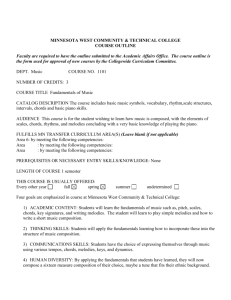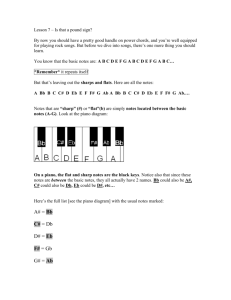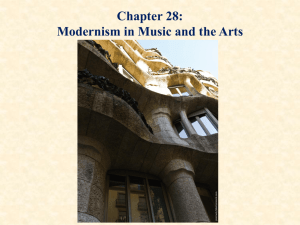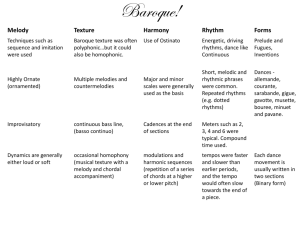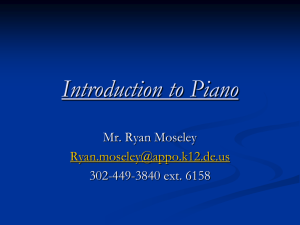QCC COURSE ASSESSMENT FORM QCC C A
advertisement
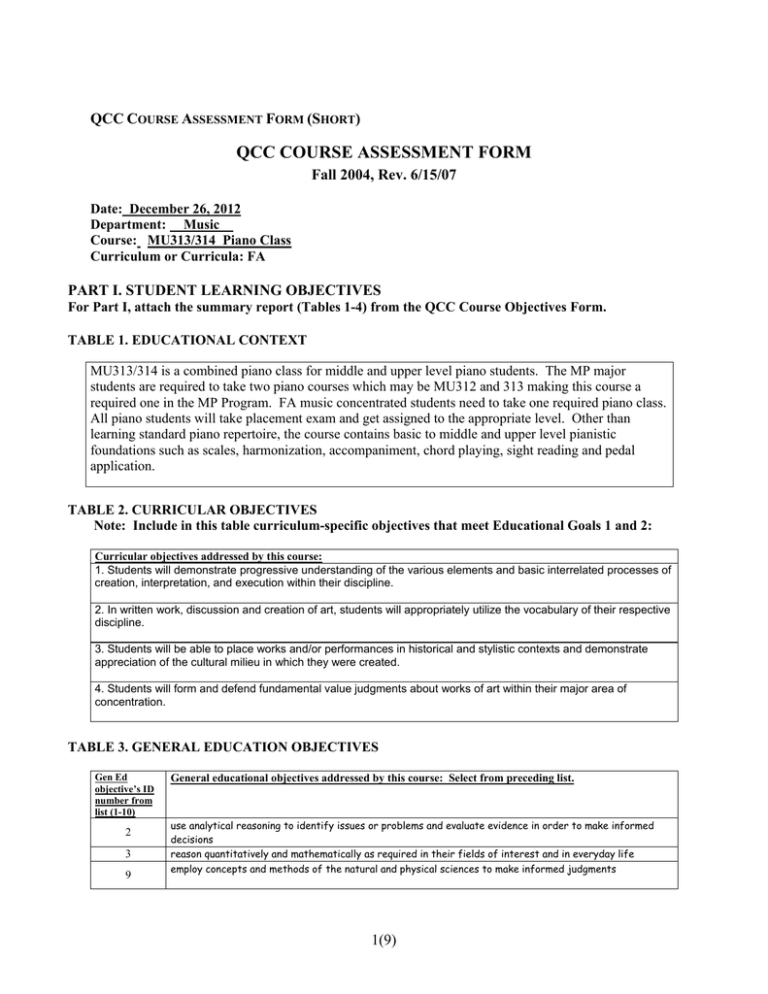
QCC COURSE ASSESSMENT FORM (SHORT) QCC COURSE ASSESSMENT FORM Fall 2004, Rev. 6/15/07 Date: December 26, 2012 Department: Music__ Course: MU313/314 Piano Class Curriculum or Curricula: FA PART I. STUDENT LEARNING OBJECTIVES For Part I, attach the summary report (Tables 1-4) from the QCC Course Objectives Form. TABLE 1. EDUCATIONAL CONTEXT MU313/314 is a combined piano class for middle and upper level piano students. The MP major students are required to take two piano courses which may be MU312 and 313 making this course a required one in the MP Program. FA music concentrated students need to take one required piano class. All piano students will take placement exam and get assigned to the appropriate level. Other than learning standard piano repertoire, the course contains basic to middle and upper level pianistic foundations such as scales, harmonization, accompaniment, chord playing, sight reading and pedal application. TABLE 2. CURRICULAR OBJECTIVES Note: Include in this table curriculum-specific objectives that meet Educational Goals 1 and 2: Curricular objectives addressed by this course: 1. Students will demonstrate progressive understanding of the various elements and basic interrelated processes of creation, interpretation, and execution within their discipline. 2. In written work, discussion and creation of art, students will appropriately utilize the vocabulary of their respective discipline. 3. Students will be able to place works and/or performances in historical and stylistic contexts and demonstrate appreciation of the cultural milieu in which they were created. 4. Students will form and defend fundamental value judgments about works of art within their major area of concentration. TABLE 3. GENERAL EDUCATION OBJECTIVES Gen Ed objective’s ID number from list (1-10) 2 3 9 General educational objectives addressed by this course: Select from preceding list. use analytical reasoning to identify issues or problems and evaluate evidence in order to make informed decisions reason quantitatively and mathematically as required in their fields of interest and in everyday life employ concepts and methods of the natural and physical sciences to make informed judgments 1(9) 10 apply aesthetic and intellectual criteria in the evaluation or creation of works in the humanities or the arts 2(9) TABLE 4: COURSE OBJECTIVES AND STUDENT LEARNING OUTCOMES Course objectives 1. Learning outcomes Students will review chords a. Students will identify minor scales from major ones on the piano and major scales, and play b. Students will employ accurate fingerings playing minor scales in two hands and two octaves traveling in descending and ascending directions minor scales on the piano 2. Students will improve on sight reading skill a. Students will dissect information like tempo, meter, expression, notes, rhythm and dynamic on the written score. b. Students will execute the abovementioned information and integrate into sight reading skill. 3.Students will increase their musical and pianistic vocabularies/terminologies a. Students will identify and define vocabularies printed on the musical score b. Students will apply the musical terminologies on their piano solo performance. 4. Student will learn to harmonize a simple melody with functional chords (accompaniment). 5.Students will learn a few piano solo works to build piano repertoire a. Students will identify and select functional chords to harmonize the melody b. Students will write down and/or play by ears to accompany the melody assigned. 6. Students will experience collaborative 4 hand and class piano with other students. a. Students will exercise pianistic art by collaborating with fellow pianists in the class either in four-hand or group piano class playing. b. Students will apply new listening skills in ensemble playing. a. Students will illustrate assigned selected piano solo works with different technical challenges and listening skill required in weekly checkups and exams/performances. b. Students will summarize their strength and weakness in their piano performance. 3(9) PART II. ASSIGNMENT DESIGN: ALIGNING OUTCOMES, ACTIVITIES, AND ASSESSMENT TOOLS For the assessment project, you will be designing one course assignment, which will address at least one general educational objective, one curricular objective (if applicable), and one or more of the course objectives. Please identify these in the following table: TABLE 5: OBJECTIVES ADDRESSED IN ASSESSMENT ASSIGNMENT Course Objective(s) selected for assessment: (select from Table 4) 1. Students will review chords and major scales, and play minor scales on the piano 2. Student will learn to harmonize a simple melody with functional chords (accompaniment). Curricular Objective(s) selected for assessment: (select from Table 2) Students will form and defend fundamental value judgments about works of art within their major area of concentration. General Education Objective(s) addressed in this assessment: (select from Table 3) use analytical reasoning to identify issues or problems and evaluate evidence in order to make informed decisions In the first row of Table 6 that follows, describe the assignment that has been selected/designed for this project. In writing the description, keep in mind the course objective(s), curricular objective(s) and the general education objective(s) identified above, The assignment should be conceived as an instructional unit to be completed in one class session (such as a lab) or over several class sessions. Since any one assignment is actually a complex activity, it is likely to require that students demonstrate several types of knowledge and/or thinking processes. Also in Table 6, please a) identify the three to four most important student learning outcomes (1-4) you expect from this assignment b) describe the types of activities (a – d) students will be involved with for the assignment, and c) list the type(s) of assessment tool(s) (A-D) you plan to use to evaluate each of the student outcomes. (Classroom assessment tools may include paper and pencil tests, performance assessments, oral questions, portfolios, and other options.) Note: Copies of the actual assignments (written as they will be presented to the students) should be gathered in an Assessment Portfolio for this course. 4(9) TABLE 6: ASSIGNMENT, OUTCOMES, ACTIVITIES, AND ASSESSMENT TOOLS Briefly describe the assignment that will be assessed: Students will compose a melody of minimal 8 measures long or adopt an existing melody of similar length and harmonize it following the rules of music from Baroque and Classical periods they have learned from the course. Students will demonstrate use of all 7 chords from major or minor key with fluency. All the chords are to be labeled with cadences, roman numerals and non chord tones. The instructor will provide in class performance opportunity for each student to perform their own works. The students will listen and watch each performance. An election will follow for selecting the top 3 compositions to perform for the department student concert. Desired student learning outcomes for the assignment (Students will…) List in parentheses the Curricular Objective(s) and/or General Education Objective(s) (1-10) associated with these desired learning outcomes for the assignment. Briefly describe the range of activities student will engage in for this assignment. Course Objectives: 1. Students will review chords and major scales, and play minor scales on the piano 2. Student will learn to harmonize a simple melody with functional chords (accompaniment). Curricular Objectives: a. Select one melody out of handout options b. Play through the melody well c. Decide which chords and quality of chords to accompany the melody throughout d. Write down and/or play by ears and make effective and informed decisions on what ‘sounds classical’. e. participate in class performance with a short verbal presentation Students will form and defend fundamental value judgments about works of art within their major area of concentration. General Objectives: 3. 4. use analytical reasoning to identify issues or problems and evaluate evidence in order to make informed decisions 5(9) What assessment tools will be used to measure how well students have met each learning outcome? (Note: a single assessment tool may be used to measure multiple learning outcomes; some learning outcomes may be measured using multiple assessment tools.) Students will accompany the assigned melody in the western functional harmonization with single note, interval or chords. Different styles of accompaniment handout styles are given. PART III. ASSESSMENT STANDARDS (RUBRICS) Before the assignment is given, prepare a description of the standards by which students’ performance will be measured. This could be a checklist, a descriptive holistic scale, or another form. The rubric (or a version of it) may be given to the students with the assignment so they will know what the instructor’s expectations are for this assignment. Please note that while individual student performance is being measured, the assessment project is collecting performance data ONLY for the student groups as a whole. TABLE 7: ASSESSMENT STANDARDS (RUBRICS) Brief description of assignment: (Copy from Table 6 above) Students will compose a melody of minimal 8 measures long or adopt an existing melody of similar length and harmonize it following the rules of music from Baroque and Classical periods they have learned from the course. Students will demonstrate use of all 7 chords from major or minor key with fluency. All the chords are to be labeled with cadences, roman numerals and non chord tones. The instructor will provide in class performance opportunity for each student to perform their own works. The students will listen and watch each performance. An election will follow for selecting the top 3 compositions to perform for the department student concert. Desired student learning outcomes from the assignment: (Copy from Column 1, Table 6 above; include Curricular and /or General Education Objectives addressed) Course Objectives: 1. Students will review chords and major scales, and play minor scales on the piano 2. Student will learn to harmonize a simple melody with functional chords (accompaniment). Curricular Objectives: Students will form and defend fundamental value judgments about works of art within their major area of concentration. General Objectives: 3. 4. Assessment measures for each learning outcome: (Copy from Column 3,Table 6 above) Students will accompany the assigned melody in the western functional harmonization with single note, interval or chords. Different styles of accompaniment handout styles are given. use analytical reasoning to identify issues or problems and evaluate evidence in order to make informed decisions 6(9) Standards for student performance: Describe the standards or rubrics for measuring student achievement of each outcome in the assignment. Give the percentage of the class that is expected to meet these outcomes If needed, attach copy(s) of rubrics Live performance is assessed by fluency of the melody playing and choices of chords selected to support the melody note by note or by measure. Sound quality of the accompaniment itself Choice of styles in the accompaniment 80% of students may meet the expected outcome 100% perfection 90% Above average with minor mistakes 80% Satisfactory with minor mistakes 70% Satisfactory with some mistakes 60% Average with audible mistakes 50% Fail of the course PART IV. ASSESSMENT RESULTS TABLE 8: SUMMARY OF ASSESSMENT RESULTS Use the following table to report the student results on the assessment. If you prefer, you may report outcomes using the rubric(s), or other graphical representation. Include a comparison of the outcomes you expected (from Table 7, Column 3) with the actual results. NOTE: A number of the pilot assessments did not include expected success rates so there is no comparison of expected and actual outcomes in some of the examples below. However, projecting outcomes is an important part of the assessment process; comparison between expected and actual outcomes helps set benchmarks for student performance. TABLE 8: SUMMARY OF ASSESSMENT RESULTS Desired student learning outcomes: (Copy from, Column 1,Table 6 above; include Curricular and/or General Education Objectives addressed) Course Objectives: 1. Students will review chords and major scales, and play minor scales on the piano 2. Student will learn to harmonize a simple melody with functional chords (accompaniment). Curricular Objectives: Students will form and defend fundamental value judgments about works of art within their major area of concentration. General Objectives: Student achievement: Describe the group achievement of each desired outcome and the knowledge and cognitive processes demonstrated. Students achieved average 80% from the rubrics in table 7 as expected. Students demonstrated understanding of choosing the chord that includes the notes from the melody. Students applied artistic views in making their choices of chords for the melody. Students integrated their knowledge from MU208, 209 and/or 241 theory courses within their major program in the process of selecting the chords For each melodic note, students have three choices of chords they may apply. Students employed their analytical reasoning, evaluating evidences and cultivated musical aesthetic tastes to make the informed decisions on their choices of accompaniment styles and chords. 3. 4. use analytical reasoning to identify issues or problems and evaluate evidence in order to make informed decisions . 7(9) TABLE 9. EVALUATION AND RESULTING ACTION PLAN In the table below, or in a separate attachment, interpret and evaluate the assessment results, and describe the actions to be taken as a result of the assessment. In the evaluation of achievement, take into account student success in demonstrating the types of knowledge and the cognitive processes identified in the Course Objectives. A. Analysis and interpretation of assessment results: What does this show about what and how the students learned? 20 students from MP and FA major students were enrolled. 15 were in MU313 and 5 were in MU314. The ratio between FA and MP out of the 20 was around 3:1. In general, FA students tend to have more training in piano and theory. However, MP students in the class made tremendous progress in this class. 19 students completed this task and their performance was rated according to fluency, choices of the chords, and choice of the accompaniment style. The average of the score is 75 (based on 100 points) from MU313 and 85 from MU314. The choice of accompaniment style was 90% simple chords with 5% single notes and 5% Rock&Roll style. The choices of chords was rated 70% while fluency is 85%. Majority of them understood the concept and had spent time practicing. All of them played through with some chords. However, more practice of inversions making less movements on the piano for fluency was required. B. Evaluation of the assessment process: What do the results suggest about how well the assignment and the assessment process worked both to help students learn and to show what they have learned? This course is one credit. Within an hour and 50 minute period of time, faculty member tried to include all average attending students, 18, within the time, teaching a new scale each week, checking everyone’s solo piece progress while teaching sight reading and this accompaniment task. The time is limited. In addition, this task was offered to train pianistic accompaniment skill as well as integrating theory knowledge in making the right choices in harmonization of the melody. Demonstration from a few students each week on the 2nd half of the semester as well as from the professor was given. Students were well-informed what to do in the assignment and how they would be assessed. Verbal feedback, sharing, written theory practice were encouraged. The results suggested that students need to practice more on this task and stick to same choices of chords for accompaniment to ensure fluency in their performances. During their exam performance, they would make immediate changes of chords if it didn’t sound right suggested that most students were aware and could differentiate from ‘better’ to ‘not so good’ choices. It exhibited that they could hear the right choice of chords in their mind but the execution part, more practice time, shall be enforced. C. Resulting action plan: 8(9) Based on A and B, what changes, if any, do you anticipate making? Smaller class size may prompt more individual in-class time with each student due to the fact that the problems each student exhibited was quite different. Therefore, each student needed more time to practice and work with the professor. QCC 12/3/04 9(9) QCC COURSE OBJECTIVES FORM (SHORT) QCC COURSE OBJECTIVES FORM (Short) Fall 2004, rev. 6/15/07 Date: December 26, 2012 Department: Music__ Course: MU313/314 Piano Class Curriculum or Curricula: FA TABLE 1: EDUCATIONAL CONTEXT OF THE COURSE Educational Context: MU313/314 is a combined piano class for middle and upper level piano students. The MP major students are required to take two piano courses which may be MU312 and 313 making this course a required one in the MP Program. FA music concentrated students need to take one required piano class. All piano students will take placement exam and get assigned to the appropriate level. Other than learning standard piano repertoire, the course contains basic to middle and upper level pianistic foundations such as scales, harmonization, accompaniment, chord playing, sight reading and pedal application. TABLE 2: CURRICULAR OBJECTIVES Note: Include in this table curriculum-specific objectives that meet Educational Goals 1 and 2: Curricular objectives addressed by this course Briefly describe activities in this course which help students meet each of these curricular objectives 1. Students will demonstrate progressive understanding of the various elements and basic interrelated processes of creation, interpretation, and execution within their discipline. 2. In written work, discussion and creation of art, students will appropriately utilize the vocabulary of their respective discipline. Students will be given a simple melody and pianistic accompaniment patterns to learn to accompany the melody in the functional harmony. 3. Students will be able to place works and/or performances in historical and stylistic contexts and demonstrate appreciation of the cultural milieu in which they were created. Students will be required to learn a few pieces in different styles or historical context to build up their repertoire, such as Baroque, Classical, Romantic, Contemporary, Pop and Jazz. Students will demonstrate knowledge of musical vocabularies in Italian, German and French from music scores. 4. Students will form and defend fundamental value judgments about works of art within their major area of concentration. Students are required to learn minor scales (mostly harmonic ones) and execute them in both hands together in two octaves with accurate fingerings. Students will get a new sight reading material and a few minutes before playing it together in a few of the class. Students will learn to incorporate accurate notations, rhythm, dynamics, expressions, tempo, articulation and stylistic and pianistic interpretation of the piano solo works assigned. TABLE 3: GENERAL EDUCATION OBJECTIVES Gen ed objective’s General educational objectives addressed by this course: Select Briefly describe activities in the course which help students meet each of these general education 1(4) identification number from preceding list (1-10) from preceding list. objectives use analytical reasoning to identify issues or problems and evaluate evidence in order to make informed decisions 2 reason quantitatively and mathematically as required in their fields of interest and in everyday life 3 9 Students will learn to evaluate the quality of their weekly practice and performance in class Students will distinguish the sound from their heart than the sound they hear they play thus make appropriate changes to improve. Students will learn appropriate method for practice and performance. Students will employ technology like metronome, and /or recording device from smart phone/computer to analyze, process and assist the accuracy and efficiency of their ‘daily’ practice. Students will learn to organize the practice schedule and estimate the amount of time spent on the piano solo piece in order to be ready for weekly class checkup, thus incorporate the practice routine into their everyday life. employ concepts and methods of the natural and physical sciences to make informed judgments Students will learn correct sitting, shoulder, arm, wrist postures and fingerings when practice and perform piano. apply aesthetic and intellectual criteria in the evaluation or creation of works in the humanities or the arts Students will analyze the form and compositional structure of the music. Students will evaluate ways to practice for maximum results. Students will perform and evaluate stylistically, esthetically and artistically of assigned piano solo works. 10 2(4) Note: Table 4 is prepared in two stages. Column 1 is prepared first. COLUMN 1 OF TABLE 4: COURSE OBJECTIVES:DESIRED STUDENT LEARNING 1.Students will review chords and major scales, and play minor scales on the piano 2.Students will improve on sight reading skill 3.Students will increase their musical and pianistic vocabularies/terminologies 4. Student will learn to harmonize a simple melody with functional chords (accompaniment). 5.Students will learn a few piano solo works to build piano repertoire 6. Students will experience collaborative 4 hand and class piano with other students. TABLE 4: COURSE OBJECTIVES AND STUDENT LEARNING OUTCOMES Course objectives (Note: copy objectives from the above Column 1 of Table 4 directly into this column.) 1.Students will review chords and major scales, and play minor scales on the piano 2.Students will improve on sight reading skill Learning outcomes a. Students will identify minor scales from major ones on the piano b. Students will employ accurate fingerings playing minor scales in two hands and two octaves traveling in descending and ascending directions a. Students will dissect information like tempo, meter, expression, notes, rhythm and dynamic on the written score. b. Students will execute the abovementioned information and integrate into sight reading skill. 3.Students will increase their musical and pianistic vocabularies/terminologies 4. Student will learn to harmonize a simple melody with functional chords (accompaniment). a. Students will identify and define vocabularies printed on the musical score b. Students will apply the musical terminologies on their piano solo performance. 5.Students will learn a few piano solo works to build piano repertoire a. Students will illustrate assigned selected piano solo works with different technical challenges and listening skill required in weekly checkups and exams/performances. b. Students will summarize their strength and weakness in their piano performance. 6. Students will experience collaborative 4 hand and class piano with other students. a. Students will exercise pianistic art by collaborating with fellow pianists in the class either in four-hand or group piano class playing. b. Students will apply new listening skills in ensemble playing. a. Students will identify and select functional chords to harmonize the melody b. Students will write down and/or play by ears to accompany the melody assigned. QCC 8/12/04 3(4) GLOSSARY OF TERMS Note: These definitions of terms are for the purposes of this assessment project only Entry-level course A credit course with no pre-requisites other than passing placement exams or required remediation; usually considered a first semester course; this course may be a pre-requisite for mid-level courses Mid-level course A course which has at least one credit course as a pre-requisite; usually a second or third semester course; this course may be a pre-requisite for upper-level courses Upper-level course A course, usually taken in the third or fourth semester, which has several credit course prerequisites (Student) Learning objectives An explicit statement of the skills and knowledge a student is expected to learn and be able to demonstrate either in general education, in a curriculum, or in a course (Student) Learning outcomes Student behaviors, performance, or activities that demonstrate that students are meeting or have met the learning objective(s) General education objectives Desired student learning in general education skills and in the liberal arts and sciences: communication, analytic reasoning and problem solving, quantitative skills and mathematical reasoning, information management, integration of knowledge, differentiation of values, development of personal and collaborative skills, history, social sciences, mathematics and sciences, the humanities and the arts Curricular objectives An explicit statement of the major points of learning that students must achieve to complete a program of study; these include both general education objectives and objectives specific to the curriculum Course objectives Major points of learning that students must achieve to complete a course; course objectives include general education objectives, curricular objectives, and objectives specific to the course 4(4)

